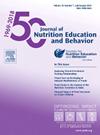餐厅经理对份量大小的信念如何影响顾客的剩菜
IF 2.3
3区 医学
Q2 EDUCATION, SCIENTIFIC DISCIPLINES
引用次数: 0
摘要
餐馆提供的食物往往超过个人适当的能量需求,造成健康问题并增加食物浪费。其中一个因素是顾客更喜欢大份量(PS)。但是,PS可以同时考虑其表观PS和实际能量含量。通过加入蔬菜等低能量食材,餐厅可以在保持表面PS的同时降低能量含量,从而减少顾客的剩菜。目的研究餐厅管理者的PS信念对顾客剩菜剩菜的影响。研究设计、环境、参与者2019年5月,日本对396家餐馆老板进行了一项在线调查。被调查者回答了两个与PS相关的问题:“大的PS对于顾客的满意度是必不可少的”和“如果提供健康的一餐,这顿饭的表观PS会比现在减少”,选择“同意”或“不同意”。根据他们的反应,他们被分为三组PS信念:(A)大PS是必要的,我不会在提供健康膳食时保持表面PS; (B)大PS是必要的,我将在提供健康膳食时保持表面PS; (C)大PS不是必要的。受访者还将他们的顾客剩菜分类为经常/有时或很少。可测量的结果/分析我们进行了卡方检验和逻辑回归,以顾客剩菜为因变量(参考:经常/有时),PS信念为自变量,人口统计为协变量。结果103名酒楼老板(26.0%)表示顾客“经常/有时”把食物留作剩菜。其中A组193人(48.7%),B组143人(36.1%),C组60人(15.2%)。以A组为参照,B组很少有顾客剩菜的比值比(OR)和95%置信区间(CI)分别为1.74[1.02-2.95]和3.88[1.68-8.93]。这些发现表明,在老板认为提供更健康的食物与保持大份量的外观相一致的餐馆,顾客的剩菜往往更少。资助jsps KAKENHI,资助编号(C)18K02219本文章由计算机程序翻译,如有差异,请以英文原文为准。
How Restaurant Managers' Beliefs on Portion Size Influence Customer Leftovers
Background
Meals served in restaurants often exceed individuals’ appropriate energy requirements, contributing to health issues and increased food waste. One contributing factor is that customers prefer large portion sizes (PS). However, PS can be considered in terms of both its apparent PS and actual energy content. By incorporating low-energy ingredients such as vegetables, restaurants would maintain the apparent PS while reducing energy content, leading to reducing customer leftovers.
Objective
This study examines how restaurant managers’ PS beliefs influence customer leftovers.
Study Design, Settings, Participants
An online survey was conducted in May 2019 on 396 restaurant owners in Japan. The respondents answered two PS-related questions: "large PS is essential for customer satisfaction" and "If offering a healthy meal, the apparent PS of the meal would be reduced compared to now," selecting "agree" or "disagree." Based on the responses, they were categorized into three groups of PS beliefs: (A) large PS is essential and I wouldn’t maintain the apparent PS while offering a healthy meal, (B) large PS is essential and I would maintain the apparent PS while offering a healthy meal, and (C) large PS is not essential. The respondents also classified their customer leftovers as often/sometimes or rarely.
Measurable Outcome/Analysis
We conducted chi-square tests and logistic regression, with customer leftovers as the dependent variable (reference: often/sometimes), PS beliefs as the independent variable, and demographics as covariates.
Results
One hundred three restaurant owners (26.0%) reported that customers “often/sometimes” left food uneaten. Among the respondents, 193 (48.7%) were in Group A, 143 (36.1%) in Group B, and 60 (15.2%) in Group C. Using Group A as the reference, the odds ratio (OR) and 95% confidence interval (CI) of having rarely customer leftovers for Group B were 1.74 [1.02–2.95] and Group C were 3.88 [1.68–8.93].
Conclusions
These findings suggest that customer leftovers tend to be lower at restaurants where owners believe that offering healthier meals is compatible with maintaining the appearance of large portion sizes.
Funding
JSPS KAKENHI under Grant Number(C)18K02219
求助全文
通过发布文献求助,成功后即可免费获取论文全文。
去求助
来源期刊
CiteScore
4.20
自引率
11.50%
发文量
379
审稿时长
44 days
期刊介绍:
The Journal of Nutrition Education and Behavior (JNEB), the official journal of the Society for Nutrition Education and Behavior, is a refereed, scientific periodical that serves as a global resource for all professionals with an interest in nutrition education; nutrition and physical activity behavior theories and intervention outcomes; complementary and alternative medicine related to nutrition behaviors; food environment; food, nutrition, and physical activity communication strategies including technology; nutrition-related economics; food safety education; and scholarship of learning related to these areas.
The purpose of JNEB is to document and disseminate original research and emerging issues and practices relevant to these areas worldwide. The Journal of Nutrition Education and Behavior welcomes evidence-based manuscripts that provide new insights and useful findings related to nutrition education research, practice and policy. The content areas of JNEB reflect the diverse interests in nutrition and physical activity related to public health, nutritional sciences, education, behavioral economics, family and consumer sciences, and eHealth, including the interests of community-based nutrition-practitioners. As the Society''s official journal, JNEB also includes policy statements, issue perspectives, position papers, and member communications.

 求助内容:
求助内容: 应助结果提醒方式:
应助结果提醒方式:


